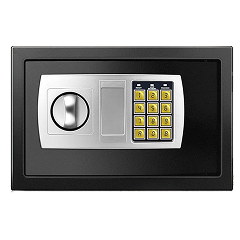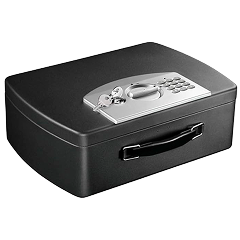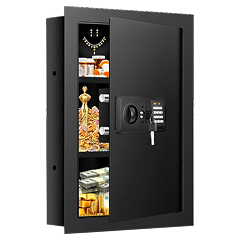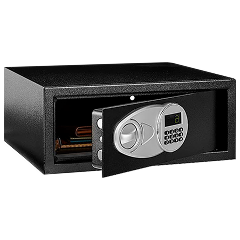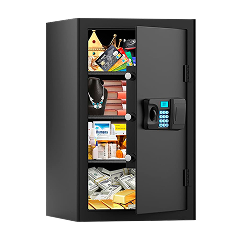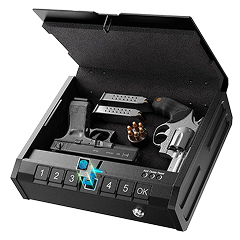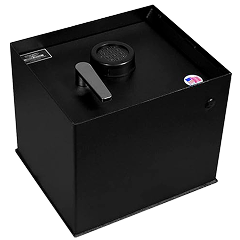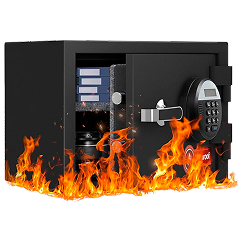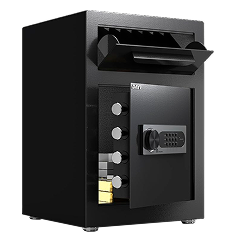House fires don’t wait for convenient timing. I learned this as an engineer who understood the statistics but needed practical protection for my family’s documents.
After researching fire ratings, temperature thresholds, and water damage from firefighting efforts, I bought two safes: a traditional combination lock model and a fire-rated safe with key access. Both serve different purposes, but the fire safe handles our most valuable papers and digital backups.
This guide focuses on fire safes and the technical decisions that matter when your house reaches 1,200°F and firefighters flood your home with thousands of gallons of water. I’ll walk you through fire ratings, water protection, lock reliability under extreme heat, and capacity planning based on real usage patterns.
While our main home safe guide covers security features and general safe selection, this concentrated guide addresses the engineering challenges fire safes face and helps you choose protection that works when disaster strikes.
Understanding Fire Ratings: What Really Matters
From an engineering perspective, fire ratings represent the difference between salvageable documents and ash piles, but testing standards and real-world applications don’t always align.
Fire Rating Certifications: UL vs. ETL Testing Standards
UL (Underwriters Laboratories) and ETL (Edison Testing Laboratories) both conduct independent fire testing. However, I found UL’s protocols are more rigorous after reviewing their test procedures.
UL subjects safes to actual furnace conditions that mirror house fire temperatures, while some ETL tests use shorter exposures that may not reflect the 45-60 minute burn times common in residential fires.
When purchasing my fire safe, I sought UL certification because their testing includes thermal shock: rapidly cooling the heated safe with water to simulate firefighting conditions.
Temperature Thresholds: The Reality of House Fire Heat
Ten minutes into a house fire, temperatures hit 1,100°F. Then it shoots up to 1,800°F if you’ve got synthetic carpets or furniture. I went with a 1,400°F-rated safe because it gives me decent breathing room above normal fire temps without breaking the bank.
Safes rated only to 1,200°F leave a minimal safety margin, especially since internal temperatures can damage paper at 350°F even when the exterior rating holds. The 1,700°F+ rated safes offer better protection but cost much more, making them worth it for irreplaceable items like original birth certificates or family photos.
Fire Duration: How Long Protection Actually Lasts
Standard fire ratings cover 30 minutes, 1 hour, or 2 hours of continuous fire exposure, but real house fires vary dramatically. Research into local fire department response times influenced my decision to buy a 1-hour rated safe, since our rural area averages 12-15 minute response times plus additional suppression time.
The 30-minute safes work for urban areas with rapid fire response, while 2-hour protection makes sense for remote locations or homes storing business documents that insurance can’t replace.
Water Resistance: The Overlooked Factor
Homeowners focus entirely on fire protection and ignore the water damage that destroys safe contents after firefighters finish their work. A local house fire resulted in 4,000 gallons of water flooding their basement.
Their “fireproof” safe kept documents dry during the blaze but failed when submerged for 18 hours. This experience shaped my decision to prioritize 24+ hour waterproof ratings over higher fire temperature thresholds, since water damage occurs in nearly every structure fire that gets extinguished.
The difference between “water resistant” and “waterproof” ratings matters more than manufacturers want you to know. Water-resistant safes might survive sprinkler systems, but waterproof models with ETL certification handle complete submersion for extended periods.
My fire safe carries a 24-hour waterproof rating, providing peace of mind during cleanup when water sits in basements for days. Independent testing from ETL or UL beats manufacturer claims; too many “waterproof” safes fail when actually tested by third parties.
Choosing the Right Capacity for Your Needs
Fire safes require different capacity calculations because insulation materials eat up interior space, and you need room for document organization that won’t melt under extreme heat.
Here’s the reality check: my 0.6 cubic foot safe barely fits 200 sheets once I use fire-resistant folders and leave space for things to expand when they heat up. Regular hanging folders turn into warped messes at high temperatures, so I ditched them for accordion organizers that keep papers separated even when hot.
Manufacturers count on you stuffing everything together like a filing cabinet, but try finding your insurance card in that mess during an emergency. After storing passports, policies, and backup drives for two years, expect about 30% less room than whatever the box claims.
Lock Type Trade-Offs: Balancing Security and Access
Electronic locks worry me on fire safes because high temperatures can damage circuits and battery compartments, potentially locking you out when access is needed most. My combination safe hasn’t failed in three years, while friends with electronic fire safes report occasional lockouts during power outages or after battery changes.
Dial locks run on basic physics; no batteries, no circuits, nothing to fry when things get hot. Sure, they’re slower to open when you’re stressed, but they work every time. Biometric systems? That’s like betting your documents on technology that melts under fire conditions. Those fingerprint readers and computer chips aren’t built for 1,400°F heat.
Key locks offer the most reliable backup. My keyed fire safe opens instantly even after sitting through temperature swings and humidity changes. However, keys can be lost or stolen, creating security risks that electronic codes avoid. Based on my research and discussions with fire safe owners, dual systems with electronic primary access and key backup provide the best balance. However, they cost more and add complexity.
Maximizing Interior Organization and Efficiency
Fire safe interiors come with basic shelving that wastes space and creates document chaos when you need papers quickly. I replaced standard shelves with adjustable wire racks that create three zones: frequently accessed documents on top, legal papers in the middle, and digital storage media in a padded bottom compartment. Fire safes need organization systems that maintain structure when heated—plastic organizers melt, while metal and fabric systems survive temperature extremes.
After two years of use, accessibility matters more than maximum capacity when organizing contents. Documents you need during emergencies should sit in front with clear labels. Long-term storage items can go deeper.
This system prioritizes quick identification over using the space more efficiently. Fumbling through disorganized papers defeats the purpose of secure storage.
Effective Fire Safe Organization Tips:
- Place insurance cards and emergency contacts in the door pocket for immediate access
- Use metal binder clips instead of plastic ones—they won’t melt and release toxic fumes
- Store USB drives and SD cards in padded sleeves to prevent thermal expansion damage
- Keep a waterproof inventory list taped inside the door listing all contents and locations
- Group documents by urgency: immediate need, insurance claims, and long-term storage
- Leave 20% empty space for air circulation and prevent document compression during heating
Anchoring and Placement Considerations
Neither of my safes is permanently mounted, which limits theft protection but works since both weigh enough to deter casual thieves. My combination safe at 80+ pounds requires two people to move, while my portable fire safe stays hidden.
From research on mounting systems, floor bolting works best because wall mounting can compromise insulation integrity and create stress points that weaken during thermal expansion. Fire safes need solid concrete foundations for proper bolt-down installation, which rules out wooden floors or basement slabs without adequate thickness.
Location matters more than mounting for fire protection effectiveness. I keep my fire safe in the basement center wall, away from potential collapse zones near exterior walls and furnace areas where fires typically start.
Upper floors face higher temperatures during fires, while basements offer cooler conditions and better structural protection. However, basements increase flood risk from firefighting water, so elevation on concrete blocks or metal stands provides the best compromise.
Maintenance Requirements and Warranty Coverage
Fire safes wear differently than regular safes because their seals and insulation break down over time. This can diminish their protection ratings. Every six months, I check my safe’s door seals for cracks or spots where the rubber has compressed.
Those gaskets keep water and heat out, but they get brittle after several years and need replacing. The lock mechanism gets graphite lubricant once a year instead of oil-based stuff that could catch fire when temperatures spike.
Regular Fire Safe Maintenance Tasks:
- Check door seals quarterly for cracks, gaps, or hardening that reduces waterproof protection
- Test lock operation monthly—both key turns and combination dials should move smoothly
- Clean interior surfaces annually with dry cloth to prevent moisture buildup
- Verify bolt-down hardware tightness if mounted (thermal expansion can loosen connections)
- Replace batteries in electronic locks before low-power warnings to avoid lockouts
Warranty coverage for fire safes focuses on replacement rather than repair because fire damage typically destroys internal components beyond salvage. My fire safe includes a lifetime after-fire replacement guarantee, which matters more than standard manufacturing warranties since the real test comes during actual fire exposure.
SentrySafe, Honeywell, and FireKing honor these claims only with proof of proper installation and maintenance, so keeping receipts protects your investment.
Balancing Cost and Protection Value
Fire safe pricing jumps dramatically with each protection level; my 1-hour rated safe costs $180, while comparable 2-hour models start around $400, and premium versions with advanced water protection reach $800+.
The cost difference between 1,200°F and 1,400°F ratings often runs $100-$150, which seems reasonable until you factor in weight increases and reduced interior space from thicker insulation. I chose middle-tier protection because my insurance documents and digital backups can be replaced, unlike family photos or original legal papers.
The temptation to buy the cheapest fire safe fades when you calculate replacement costs for documents and time lost recreating records after a fire. My engineering background taught me to evaluate protection as insurance rather than an expense.
Spending $300 on a quality fire safe beats paying thousands for document recreation, legal fees, and insurance claim delays. But plenty of folks blow money on fancy electronic locks or huge safes when a basic model would handle their paperwork just fine.
Here’s what I’ve learned about value: buy proven brands with solid warranties instead of chasing the latest features from companies that might disappear next year. A fire safe that craps out during an actual fire gives you nothing back on your investment.
Get adequate protection from established manufacturers rather than betting on unknown brands with flashy specs. When your house burns down, you’ll wish you’d spent the extra $50 for reliability.
Making the Right Choice
After owning two different safes and researching fire protection extensively, start with your actual storage needs rather than maximum capacity or premium features. Measure your documents, count your digital storage devices, and add 30% for future growth; this gives realistic capacity requirements without paying for unused space.
Match fire ratings to your local fire department response times and choose water protection based on your home’s flood risk rather than marketing claims about “ultimate protection.”
Trust your assessment of how often you’ll access the safe and pick lock types accordingly, remembering that reliability beats convenience when your house is burning. My combination safe takes longer to open but never fails, while my keyed fire safe provides instant access with zero electronic components to malfunction during emergencies.
Focus on proven protection from established manufacturers with solid warranty coverage, then organize contents for quick identification during stressful situations. The best fire safe works when disaster strikes, not the one with impressive specifications on paper.


